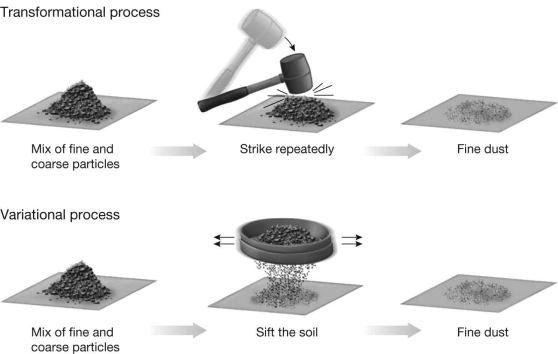Before Charles Darwin, scientists such as Jean-Baptiste Lamarck envisioned evolutionary change as transformational-properties of an ensemble change because every member of the ensemble changes. Darwin's theory of evolutionary change was, by contrast, a variational one-the properties of an ensemble change because of the action of some sorting process acting on preexisting variation within the ensemble. Referring to the figure, describe the kind of sorting process that takes place (a) when we use artificial selection to change the characteristics of a breed of animals or plants and (b) when natural selection operates on a population. 
Definitions:
Prokaryotes
Unicellular organisms that lack a membrane-bound nucleus and other organelles, with bacteria and archaea being the primary examples.
Nucleotides
Fundamental components of nucleic acids like DNA and RNA, made up of a sugar molecule, a phosphate group, and a nitrogen-containing base.
Amino Acid
Organic compounds that serve as the building blocks of proteins, which are crucial for most biological processes.
Grouping
Grouping refers to the organization or arrangement of individuals, objects, or ideas into categories or clusters based on shared characteristics or themes.
Q2: The effective population size is often lower
Q8: Who stated in 1996 that '(I)t seems
Q14: Assuming the value of linkage disequilibrium (D)
Q20: Dunbar proposes that language evolved in order
Q29: If the two sister species on the
Q32: Describe two evolutionary costs and two benefits
Q35: What would a map of phenotype space
Q49: In comparing pairs of genes in the
Q50: You roll a die (the singular of
Q53: What can we conclude about a sample